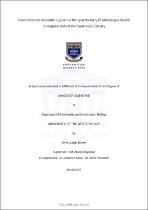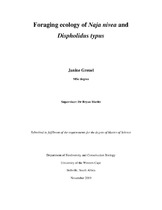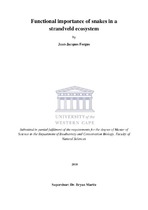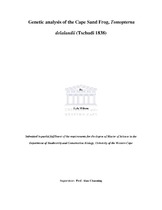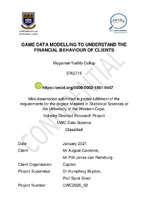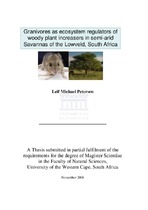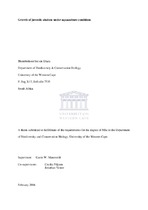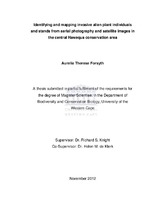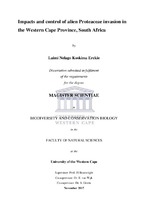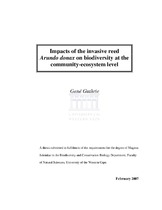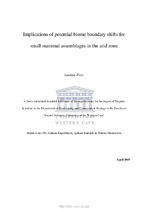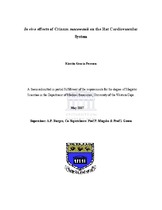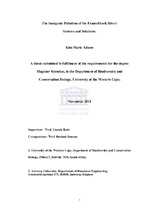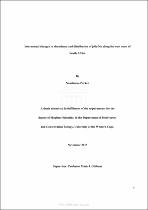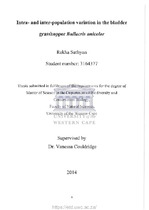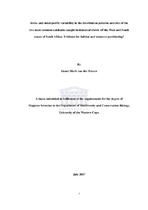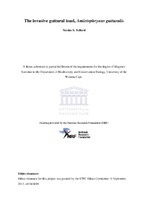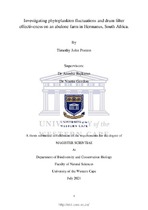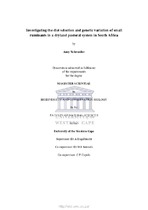Browsing Magister Scientiae (Biodiversity and Conservation Biology) - MSc (Biodiv & Cons Biol) by Title
Now showing items 54-73 of 131
-
Food resources available to juvenile fish (particularly rhabdosargus holubi) in seagrass beds of the swartkops etuary
(University of the Western Cape, 2023)Estuarine habitats are critical nursery areas for many species of marine fishes during their early life stages in terms of food availability and structural complexity, which increases survival and growth rates. The Cape ... -
Foraging ecology of Naja nivea and Dispholidus typus
(University of the Western Cape, 2019)It is widely reported that snakes can be major predators of avian nests, but the use of a single avian prey type by competing species has rarely been examined. This study aimed to investigate predation of a single food ... -
Functional importance of snakes in a strandveld ecosystem
(University of the Western Cape, 2018)Gaps in our knowledge of the functional roles of snakes within ecosystems limit our ability to predict the potentially cascading effects their removal from an ecosystem might create. Extirpation of snake species could ... -
Genetic analysis of resistance to powdery mildew (podosphaeara leucotricha) in apple (Malus x dornestica Borkh.)
(University of the Western Cape, 2008)Apple powdery mildew, caused by Podosphaera leucotricha, is one of the major diseases of the cultivated apple in the Western Cape, causing severe losses in yield and affecting fruit quality. This affects the deciduous ... -
Genetic analysis of the Cape Sand Frog, Tomopterna delalandii (Tschudi 1838)
(University of the Western Cape, 2015)Tomopterna delalandii occurs throughout the west coast, Western Cape and south coast of South Africa. This range stretches across three distinct biogeographical assemblages. Based on historical records and the fact that ... -
Genetic and morphological comparisons within the orthopteran family Pneumoridae
(University of the Western Cape, 2019)Bladder grasshoppers belong to the order Orthoptera, ancient family Pneumoridae and Superfamily Pneumoroidea. This small group of grasshoppers are sound producing, nocturnal, herbivorous grasshoppers endemic to the coastal ... -
Granivores as ecosystem regulators of woody plant increasers in semi-arid Savannas of the Lowveld, South Africa
(University of the Western Cape, 2006)In recent years, a global trend of increasing woody vegetation densities in semi-arid savanna habitats has been recorded, commonly described in South Africa as 'bush encroachment'. The shrubs and trees that do this ... -
Growth of juvenile abalone under aquaculture conditions
(University of the Western Cape, 2006)The aim of this research was, first to test the suitability of different seaweeds and formulated feeds as food for post-weaning juvenile South African abalone and secondly, to test the effects of basket design on the growth ... -
Identifying and mapping invasive alien plant individuals and stands from aerial photography and satellite images in the central Hawequa conservation area
(University of the Western Cape, 2012)The Cape Floristic Region, situated at the southern tip of Africa, is one of the world’s most botanically diverse regions. The biodiversity of this region faces various types of threats, which can be divided into three ... -
Impacts and control of alien Proteaceae invasion in the Western Cape Province, South Africa
(University of the Western Cape, 2017)Research focused on ecological impacts and control of invasive alien species (IAS) is gaining attention worldwide. The eradication and control of invasive alien plants (IAP) is essential for the restoration of native plant ... -
Impacts of the invasive reed Arundo donax on biodiversity at the community-ecosystem level
(University of the Western Cape, 2007)Arundo donax is an invasive species that mostly impacts on sensitive riparian ecosystems. Arundo is also invasive in South Africa, though less is known about its ecology, biology, and impacts. Since California and the ... -
Implications of potential biome boundary shifts for small mammal assemblages in the arid zone
(University of the Western Cape, 2019)Desertification deteriorates the landscape functionality of rangelands, affecting the resilience of biome boundaries which have a cascade effect not only in vegetation composition and characteristics but also in animal ... -
In vivo effects of crinum macowanii on the rat cardiovascular system
(University of the Western Cape, 2007)Crinum macowanii (C. macowanii) (Amaryllidacea) as authenticated by Mr. F. Weitz at the Herbarium, University of the Western cape, is widely used a traditional remedy and is thought to have therapeutic value (Fennell and ... -
The inorganic pollution of the Franschhoek River : sources and solutions
(University of the Western Cape, 2011)The aim of the study was to quantify the extent of inorganic chemical pollution of the Franschhoek River and draw relationships between contaminants in water, sediment and plants. The invasive Acacia mearnsii and Salix ... -
Interannual changes in abundance and distribution of jellyfish along the west coast of South Africa
(University of the Western Cape, 2015)Hydromedusae are mostly carnivorous planktivores that under ideal conditions can reproduce and accumulate to form dense masses of jellyfish, known as blooms. These jellyfish blooms may have various impacts on their surrounding ... -
Intra- and inter-population variation in the bladder grasshopper Bullacris unicolor
(University of the Western Cape, 2014)Although the processes that promote biodiversity and speciation remain poorly understood, ecological factors are thought to be one of the causal agents responsible for promoting variation. Bladder grasshoppers (Orthoptera; ... -
Intra- and interspecific variability in the distribution patterns and diet of the two most common catsharks caught in demersal trawls off the West and South coasts of South Africa: Evidence for habitat and resource partitioning?
(University of the Western Cape, 2017)The objective of this thesis was to elucidate intra- and interspecific variability in the distribution patterns and diet of the two most common demersal catsharks taken as by-catch by the commercial trawling industry ... -
The invasive guttural toad, Amietophrynus gutturalis
(University of the Western Cape, 2015)The guttural toad, Amietophrynus gutturalis, Power 1927, is a common toad with a broad geographic range through much of temperate, sub-tropical and tropical southern and central Africa. Introduced to the islands of Mauritius ... -
Investigating phytoplankton fluctuations and drum filter effectiveness on an abalone farm in Hermanus, South Africa.
(University of the Western Cape, 2021)Aquaculture is a growing industry in South Africa, with the production of abalone, Haliotis midae, at the forefront. The Western Cape Province hosts 12 of the 18 abalone farms in South Africa, with a concentration of ... -
Investigating the diet selection and genetic variation of small ruminants in a dryland pastoral system in South Africa
(University of the Western Cape, 2019)Small ruminants found in pastoral dryland systems face many challenges regarding constant environmental and climate changes. These variable environments are home to many pastoralists who use the natural resources to ...

